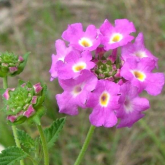Creeping lantana

Close-up of creeping lantana flower
© Queensland Government

Creeping lantana growth
© Queensland Government

Creeping lantana flowers and leaves
© Queensland Government

Immature fruit of creeping lantana
© Queensland Government

© Queensland Government

Close-up of mature fruit of creeping lantana
© Queensland Government
Native to Uruguay in South America, creeping lantana is a low growing long lived shrub that has the ability to persist during periods of extended drought and an ability to grow and reproduce under conditions of both shade and full sunlight.
In the Burnett region during the 1980s and the early 1990s the level of infestation seemed to reach a critical level and the impact of the plant increased dramatically. Some grazing properties in the North Burnett suffered decreases in carrying capacity that jeopardised the viability of those enterprises. Land values decreased and severe infestations on national parks became apparent. The plant often grows in large tracts of rough terrain where traditional control measures are not practical.
Like Lantana camara, creeping lantana is a weed in other states and around the world.
You must manage the impacts of creeping lantana on your land.
You must not give away, sell or release creeping lantana into the environment.
Scientific name
Other names
- Trailing lantana
Similar species
Description
- Low growing, creeping, shrubby plant.
- Stems are square in cross section similar to lantana but without prickles.
- Leaves are 2–3cm long, finely toothed and arranged in opposite pairs along a slender stem up to 1m long.
- Flowers are tubular in shape and form dense clusters, 1–4cm across .Flower colour is predominantly purple but can also come in yellow or white, all have a white and yellow throat.
- Fruits, fleshy, globular are up to 6–8mm in diameter.
- Fruits ripen from green to purple, containing 1 black seed.
- It has a large woody root system and develops roots on stem nodes to form dense mats.
Habitat
- Colonises diverse habitats including stony and rocky hills, alluvial flats, open woodland, riverbanks, roadsides and native pasture ecosystems.
Distribution
- Visit Weeds Australia and click on the distribution tab to access the distribution map.
Life cycle
- Flowers appear throughout most of year.
- Seed banks remain viable for at least 4 years.
Impacts
Environmental
- Becomes dominant ground cover, displacing native plants, even in undisturbed systems.
Economic
- Invades native and improved pastures, replacing desirable species.
How it is spread
- Spread by fruit-eating birds and people.
- Stems can root at nodes where they touch the soil.
- Occasionally dispersed in dumped garden waste.
Prevention
Control
Physical control
Pasture management
- Monitor pasture condition and spell and resow as required.
- Conservative stocking rates combined with some form of pasture spelling and judicious use of fire is likely to be the most effective way to maintain the vigour and competitive ability of native pastures.
Fire
- Burn regularly to reduce lantana's survival, but be aware that initial kill rates will vary. Effectiveness of burning will depend on the suitability of available fuel loads, fire intensity, temperature, relative humidity, soil moisture and season.
- Then re-establish pasture to provide competition to inhibit lantana seed germination.
- Fire is not recommended in areas such as rainforest and wooded or plantation areas, which are not fire-tolerant.
- A typical fire control program could contain the following steps:
- exclude stock to establish a pasture fuel load
- burn (may require a permit)
- sow improved pastures
- continue to exclude stock until pasture has established and seeded
- burn again in summer before rain
- spot spray creeping lantana regrowth when it is actively growing.
Mechanical control
- Stick raking, dozing or ploughing can be effective in removing plants. However, regrowth from stumps and/or increased seedling germination in disturbed soil is common and the site will require follow-up treatment.
- Grubbing of small infestations (e.g. along fence lines) can be a useful and effective way to remove plants, but is time-consuming.
- Repeated slashing can also reduce creeping lantana's vigour, exhausting its stored resources and reducing its likelihood of re-shooting.
- Some locations (e.g. very steep inclines or gullies) are not suitable for mechanical control options because of the danger of overturning machinery and soil erosion.
Herbicide control
- Variation in results can be a result of inconsistent application methods, mix rates or seasonal variation, follow up application is important.
- Remove grazing animals from spray areas during and soon after treatment. Stress can cause increased sugar levels in the leaves of lantana plants, making them more palatable.
Read the lantana fact sheet (PDF, 4.7MB) for herbicide control and application rates, check on the label that it is recommended for Lantana montevidensis.
Biological control
- No known biological control agents.
Legal requirements
- Creeping lantana is a category 3 restricted invasive plant under the Biosecurity Act 2014.
- It must not be given away, sold, or released into the environment. Penalties may apply.
- You must take all reasonable and practical measures to minimise the biosecurity risks associated with dealing with creeping lantana under your control. This is called a general biosecurity obligation (GBO).
- At a local level, each local government agency must have a biosecurity plan that covers invasive plants in its area. This plan may include actions to be taken on creeping lantana. Some of these actions may be required under local laws. Contact your local council for more information.